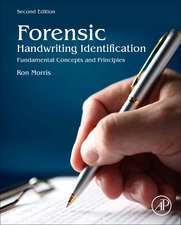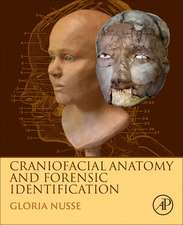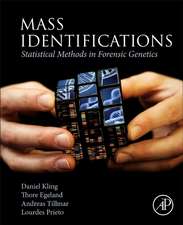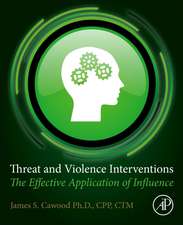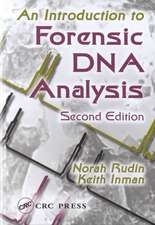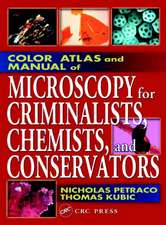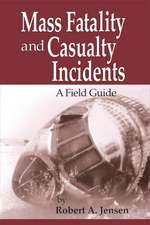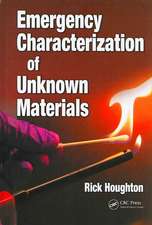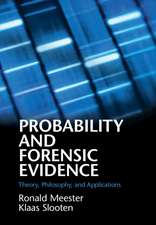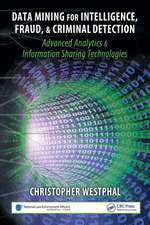Nuclear Forensic Analysis
Autor Kenton J. Moody, Patrick M. Grant, Ian D. Hutcheonen Limba Engleză Hardback – 10 dec 2014
Highlights of the Second Edition include:
- A new section on sample analysis considerations and interpretation following a post-detonation nuclear forensic collection
- New case studies, including the most wide-ranging and multidisciplinary nuclear forensic investigation conducted by Lawrence Livermore National Laboratory to date
- Expanded treatments of radiologic dispersal devices (RDDs) and statistical analysis methodologies
| Toate formatele și edițiile | Preț | Express |
|---|---|---|
| Paperback (1) | 679.61 lei 6-8 săpt. | |
| Taylor & Francis – 31 mar 2021 | 679.61 lei 6-8 săpt. | |
| Hardback (1) | 1040.75 lei 6-8 săpt. | |
| Taylor & Francis – 10 dec 2014 | 1040.75 lei 6-8 săpt. |
Preț: 1040.75 lei
Preț vechi: 1381.80 lei
-25% Nou
Puncte Express: 1561
Preț estimativ în valută:
199.14€ • 208.48$ • 164.78£
199.14€ • 208.48$ • 164.78£
Carte tipărită la comandă
Livrare economică 05-19 aprilie
Preluare comenzi: 021 569.72.76
Specificații
ISBN-13: 9781439880616
ISBN-10: 1439880611
Pagini: 524
Ilustrații: 50 b/w images
Dimensiuni: 156 x 234 x 30 mm
Greutate: 1.9 kg
Ediția:Revizuită
Editura: Taylor & Francis
Colecția CRC Press
Locul publicării:Oxford, United Kingdom
ISBN-10: 1439880611
Pagini: 524
Ilustrații: 50 b/w images
Dimensiuni: 156 x 234 x 30 mm
Greutate: 1.9 kg
Ediția:Revizuită
Editura: Taylor & Francis
Colecția CRC Press
Locul publicării:Oxford, United Kingdom
Public țintă
Academic and Professional Practice & DevelopmentCuprins
Introduction. Physical Basis of Nuclear Forensic Science. Engineering Issues. Chemistry and Nuclear Forensic Science. Principles of Nuclear Explosive Devices and Debris Analysis. Chronometry. Techniques for Small Signatures. Collateral Forensic Indicators. Sample Matrices and Collection. Radiochemical Procedures. Inorganic/Isotopic Sample Preparation. Organic Sample Preparation. Extraordinary Sample Issues. Field Collection Kits. NDA Field Radioactivity Detection. Laboratory Analyses. Inferred Production Estimates. Materials Profiling. Source and Route Attribution. Forensic Investigation of a Highly Enriched Uranium Sample Interdicted in Bulgaria. Counterforensic Investigation of US Enrichment Plants. Nuclear Smuggling Hoax: D- Counterweight. Nuclear Smuggling Hoax: Sc Metal. Fatal "Cold Fusion" Explosion. Questioned Sample from the US Drug Enforcement Agency. Radioactive Pillow Shipment. Afghanistan Scam Specimens. Index.
Notă biografică
Kenton J. Moody is with the Nuclear Chemistry Division at Lawrence Livermore National Laboratory (LLNL), where he is a technical leader for the application of nuclear and radiochemical techniques to problems in national security and the U.S. nuclear stockpile. He also performs basic research on the heaviest elements. In addition to numerous classified reports detailing the performance of nuclear explosive devices, he has coauthored more than 100 refereed journal publications in the subject areas of the decay properties of the heaviest elements, nuclear reaction mechanisms, fission, and nuclear structure. He has co-discovered six chemical elements and more than four dozen heavy-element isotopes.
Patrick M. Grant has been a staff member at Livermore National Laboratory since 1983, serving as the deputy director and special operations and samples manager of the Forensic Science Center. In addition to numerous classified and law enforcement reports, he has authored or coauthored more than 120 refereed publications in the open literature in diverse subject areas. He has been a fellow of the American Academy of Forensic Sciences since 1999 and a member of the editorial board of the Journal of Forensic Sciences since 2003. One of his unclassified investigations, a scientific explanation for the Riverside Hospital Emergency Room "Mystery Fumes" incident, was extensively highlighted in the popular media and is now appearing in fundamental forensic science textbooks.
Ian D. Hutcheon is the deputy director of the Glenn Seaborg Institute, the Chemical and Isotopic Signatures group leader in the Nuclear and Chemical Sciences Division, and a Distinguished Member of the Technical Staff at Lawrence Livermore National Laboratory. He has authored over 180 publications in peer-reviewed journals in the areas of secondary-ion mass spectrometry, the early history of the solar system, and nuclear forensic analysis. He also serves on the review panels of the NASA Cosmochemistry Program and the Sample Return Laboratory Instruments and Data Analysis Program. He is a member of the American Geophysical Union and a fellow of the Meteoritical Society.
Patrick M. Grant has been a staff member at Livermore National Laboratory since 1983, serving as the deputy director and special operations and samples manager of the Forensic Science Center. In addition to numerous classified and law enforcement reports, he has authored or coauthored more than 120 refereed publications in the open literature in diverse subject areas. He has been a fellow of the American Academy of Forensic Sciences since 1999 and a member of the editorial board of the Journal of Forensic Sciences since 2003. One of his unclassified investigations, a scientific explanation for the Riverside Hospital Emergency Room "Mystery Fumes" incident, was extensively highlighted in the popular media and is now appearing in fundamental forensic science textbooks.
Ian D. Hutcheon is the deputy director of the Glenn Seaborg Institute, the Chemical and Isotopic Signatures group leader in the Nuclear and Chemical Sciences Division, and a Distinguished Member of the Technical Staff at Lawrence Livermore National Laboratory. He has authored over 180 publications in peer-reviewed journals in the areas of secondary-ion mass spectrometry, the early history of the solar system, and nuclear forensic analysis. He also serves on the review panels of the NASA Cosmochemistry Program and the Sample Return Laboratory Instruments and Data Analysis Program. He is a member of the American Geophysical Union and a fellow of the Meteoritical Society.
Recenzii
Praise for the First Edition
"This book by three of the leading authorities in the field outlines a critically important area of forensic science in the modern world. … should be in the library of every forensic laboratory."
—Chemistry Professor W.F. Kinard, College of Charleston, in The Journal of Forensic Sciences
"This book by three of the leading authorities in the field outlines a critically important area of forensic science in the modern world. … should be in the library of every forensic laboratory."
—Chemistry Professor W.F. Kinard, College of Charleston, in The Journal of Forensic Sciences
Descriere
Now in its second edition, this book provides a multidisciplinary reference for forensic scientists, analytical and nuclear chemists, and nuclear physicists. The authors focus particularly on the chemical, physical, and nuclear aspects associated with the production or interrogation of a radioactive sample. They consolidate fundamental principles of nuclear forensic analysis, all pertinent protocols and procedures, computer modeling development, interpretational insights, and attribution considerations. The principles are then detailed in application to real-world investigations and casework. This edition includes a new section on sample analysis considerations and interpretation following a post-detonation nuclear forensic collection, new case studies, and expanded treatments of radiologic dispersal devices (RDDs) and statistical analysis methodologies.

